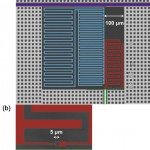
We describe a chip-based, solid-state analog of cavity-QED utilizing acoustic phonons instead of photons. We show how long-lived and tunable acceptor impurity states in silicon nanomechanical cavities can play the role of a matter nonlinearity for coherent phonons just as, e.g., the Josephson qubit plays in circuit QED. Both strong coupling (number of Rabi oscillations ≲100) and strong dispersive coupling (0.1–2 MHz) regimes can be reached in cavities in the 1–20-GHz range, enabling the control of single phonons, phonon-phonon interactions, dispersive phonon readout of the acceptor qubit, and compatibility with other optomechanical components such as phonon-photon translators. We predict explicit experimental signatures of the acceptor-cavity system.
